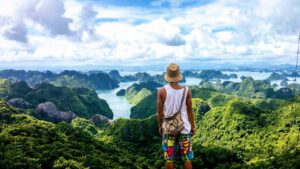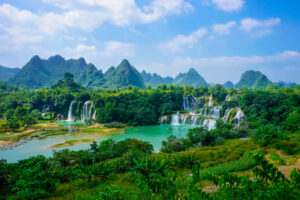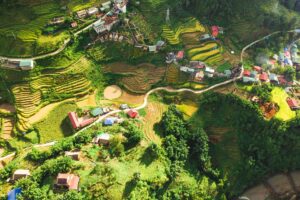Vietnam
Nestled in Southeast Asia’s heartland, Vietnam is home to a rich history, a vibrant culture, and stunning landscapes. From the hustle and bustle of Hanoi, to the tranquil waters of Ha Long Bay, and the historical remains of centuries-old cities, Vietnam has something for everyone.
On this journey through the land of the blue dragon, we’ll discover some of Vietnam’s best attractions, dive into its cultural treasures, sample its delicious cuisine, and discover what makes Vietnam a global must-visit.
 Glimpses of Vietnam’s Geography
Glimpses of Vietnam’s Geography
Nestled along the eastern rim of the indochinese peninsula, Vietnam’s topography covers an area of more than 1,600 kilometers, with a mix of mountains, forests, and deltas, as well as a coastline hugging the south China Sea.
The country’s diverse topography not only adds to the country’s natural beauty, but also makes it an ideal destination for adventurous travelers.
Whether you’re trekking in the mountains of Sapa or cruising through the twisting Mekong Delta, there’s something for everyone to enjoy.
Natural Wonders
Vietnam’s natural beauty is as varied as the country’s culture. From the turquoise waters of Ha Long bay to the verdant green of the Mekong delta, nature lovers will find endless opportunities for sightseeing.
Ha Long Bay, one of the world’s UNESCO World Heritage sites, is a picturesque stretch of limestone karstic kopjes and islets. On a cruise through the bay, you’ll discover hidden caverns, floating fishing villages and a sense of serenity that contrasts with the hustle and bustle of the cities.
In the northern mountains of Sapa, the terraced rice fields make for a picturesque scene.
Trekking through these landscapes gives you the chance to get to know local ethnic communities and learn about their way of life.
Hoi An, in central Vietnam, is a charming, well-preserved town with its lantern-lit streets and ancient architecture.
The nearby Marble Mountains offer a spiritual retreat with pagodas as well as caves to explore in the lush surroundings.
Cultural immersion
Vietnam’s culture is rich with tradition, festivals, and hospitality that welcomes you with open arms. Celebrate the Lunar New Year with a colorful parade, traditional shows, and a feeling of renewal.
Hanoi’s water puppetry shows combine traditional art forms and storytelling to create a unique theatrical experience.
Explore local markets, like Ben Thanh Market, which offers a glimpse of everyday life and the artisans’ craftsmanship.
If you’re looking for a more in-depth cultural experience, consider staying at a homestay in a rural village. You’ll be able to engage with local communities, attend traditional ceremonies, and enjoy home-cooked meals, creating lasting memories and fostering cultural exchange.
Vietnam’s Coastal Charms:
 Vietnam’s beaches and islands are home to some of the most beautiful beaches and islands in the world. From the picturesque My Khe Beach in Da Nang to the stunning white sand beaches and water sports, Vietnam’s coastline is a paradise for beach lovers and water sports aficionados alike.
Vietnam’s beaches and islands are home to some of the most beautiful beaches and islands in the world. From the picturesque My Khe Beach in Da Nang to the stunning white sand beaches and water sports, Vietnam’s coastline is a paradise for beach lovers and water sports aficionados alike.
Phu Quoc island, nestled in the Bay of Thailand, is one of Vietnam’s most picturesque islands. With its white sand beaches and picturesque coral reefs, this island paradise is the perfect place to relax and enjoy the water while soaking up the culture and history of the country’s inland areas.
1. Da Nang: My Khe Beach & Beyond
My Khe Beach is one of the most famous beaches in Da Nang, and it’s easy to see why. With its powdery white sand and gentle waves, it’s the perfect spot for sunbathing and water sports.
The Dragon Bridge is a modern marvel of architecture, spanning the Han River and lighting up the night sky.
The Marble Mountains are also a great place to visit, as they are full of spiritual significance and have hidden caves. Climbing to the top of the mountain offers stunning views of the shoreline and the city.
The Cham Islands are another great place to visit in Da Nang. With its crystal clear waters, you can snorkele and dive in the Cham Islands.
2. Nha Trang – the Riviera of South China Sea
The city of Nha Trang is renowned for its long golden beaches and lively nightlife. It is a perfect combination of beach relaxation and cultural exploration. Visitors can visit the Po Nagar Cham towers, which are the remains of the Cham civilization.
There are many island hopping activities in the city. Visitors can take boat tours to the Hon Mun marine protected area and the Hon Tam island. These islands have coral reefs full of marine life and are ideal for snorkeling and nature lovers.
3. Phu Quoc Island – Paradise in the Gulf of Thailand
Phu Quoc Island is one of the most beautiful islands of the Gulf of Thailand. It is an unspoiled tropical paradise with white sand beaches such as Bai Sao or Bai Khem. The interior of the island is full of pepper plantations, dense forest and traditional fishing villages where you can see the locals living their lives.
With its coral reefs and marine life, Phu Quoc is a great place to go snorkeling or diving. The Vinpearl Safari is a conservation project that is home to a variety of wildlife including rare species native to the area.
4. Con Dao Islands – a Tranquil Escape
Situated off the southern coast of Vietnam, the Con Dao Islands offer a tranquil retreat with pristine beaches and a rich history. Once a place of political imprisonment, these islands are now a popular destination for travelers seeking seclusion and natural beauty.
On the largest island, Con Son, you can explore secluded bays such as Dam Trau and snorkeling on the coral reefs. The Con Dao Museum offers insight into the dark history of the islands and their role in Vietnam’s history.
Nature lovers can explore the islands’ lush landscapes, which are home to a variety of flora and fauna.
Diverse regions: Vietnam’s diverse landscapes.
From the highlands of the north to the cities of the south, Vietnam’s landscapes are rich and varied. Each region has its own unique geography, culture, and lifestyle. Let’s take a journey to discover Vietnam’s diverse landscapes.
1. Northern Vietnam: The Highlands and Tranquil Beauty of Sapa
Sapa is one of the most beautiful towns in the north of Vietnam. It is located in the heart of Vietnam’s highland region, and is best known for its terracotta rice fields.
The highlands of Vietnam are known for their lush vegetation and terracotta rice paddies. These terracotta paddies are carved into the hillside by ethnic minorities, creating a beautiful mosaic that changes every season.
Sapa is a picturesque town in the northern part of Vietnam, nestled in the heart of the country’s highlands, and is known for its tranquility and tranquility.
Vietnam’s highest peak, the Hoang lien Son, is home to the most beautiful landscape in the north of the country.
Ethnic Minority Communities:
Ethnic minority communities in the northern highlands include the Hmong people, the Dao people, and the Tay people. Visiting their traditional villages is a chance to see traditional ways, colorful clothing, and a culture that is deeply rooted in the area.
BA BE NATIONAL PARK:
Heading east, you’ll find Ba Be National Park, home to beautiful emerald lakes, thick forests, and majestic waterfalls. A haven for biodiversity, this park offers a tranquil escape into nature. Take a boat ride on Ba Be Lake to explore this natural wonder.
Central Vietnam: Ancient Cities and Coastal Wonders
Hoi An’s Ancient Charm:
Central Vietnam is best known for the UNESCO World Heritage site of Hoi An. The well-preserved architecture, the lantern-lit streets and the panoramic view of the Thu Bon River create an enchanting atmosphere.
The city is a living museum, where history re-enacts itself amid tailor shops, busy markets, and old homes.
Marble Mountains & Da Nang:
Next to Hoi An are the Marble Mountains, near Da Nang. These sacred mountains have pagodas and beautiful views of the coast. The coastal city of Da Nang has the famous My Khe Beach, as well as modern architectural wonders.
Hue’s Imperial City:
Further north is the city of Hue, which features an imperial citadel, royal tombs, and the Perfume River. Hue is a symbol of Vietnam’s imperial past.
3. SOUTHERN VICTORIA: THE MULTIFUNCTION IN THE SOUTHERN AREA
Ho Chi Minh City’s Modernity:
The southern area of Vietnam is characterized by its vibrant cities and the vibrant Mekong Delta. The modernity of the area lies in the heart of the country, which is the former capital city of Saigon.
The streets of Saigon are lined with colonial French architecture, and the city is home to some of the world’s most iconic landmarks, such as the “Notre-Dame” Cathedral Basilica and the “War Remnants Museum.”
Mekong Delta’s Waterways:
The Mekong Delta is known as the “Rice Bowl of Vietnam,” and is made up of a network of rivers, wetlands, and islands. In the delta, floating markets such as Cai Rang bring colorful life to the waterways, as people trade with each other from the boats. Tourists can find traditional villages, orchards full of fruit, and a way of life that is shaped by the mighty Mekong River.
Con Dao Islands:
Off the south coast, the Con Dao Islands offer secluded beaches, pristine waters, and a sense of history. Once a prison camp for political prisoners, the islands are now a peaceful retreat with secluded coves and coral reefs.
4. Central Highlands: Dalat’s Highland Retreat
Dalat – The City of Eternal Spring
Dalat is located in the Central Highlands and is known as the “City of Eternal Spring” due to its temperate climate. The city was founded by the French and is full of villas, gardens, and hills covered with pine trees. Flower Park, Elephant falls, and the tranquil Xuan Huong Lake are just a few of the things to do in Dalat.
Ethnic Diversity:
The Central Highlands are also home to a variety of ethnic minority groups, such as the Montagnards, and visiting them allows you to learn about their customs, farming methods, and festivals.
Vietnamese cuisine – a gastronomic journey
Pho, Banh Mi, and Street Food Delights
Vietnamese cuisine is one of the most popular cuisines in the world, and it’s easy to see why. Vietnam’s signature dish is Pho – a hearty noodle soup – and the country’s signature sandwich – Banh Mi – a baguette inspired by French cuisine.
Street food markets offer a wide variety of dishes, from spring rolls and pancakes to savory dishes.
Cooking classes and market adventures
Cooking classes are a great way to get up to speed on the art and science of Vietnamese cuisine. You’ll learn the ins and outs of Vietnamese cuisine by attending a cooking class.
Vietnam’s markets are where you’ll find everything from fresh herbs and spices to fresh produce. Culinary tourism is more than just a meal; it’s a cultural experience
 Adventure and Outdoor Activities
Adventure and Outdoor Activities
Vietnam is full of adventure and outdoor activities for the adventurous traveler.
From trekking in the mountains to discovering hidden waterfalls and terraced rice fields and ethnic minority villages in the coastal areas, Vietnam has something for everyone.
From snorkeling and scuba diving to island hopping, there is something for everyone in Vietnam.
The world’s largest cave, Phong Nha-K Bang National Park, is a UNESCO site that’s a paradise for cave aficionados. The challenging yet rewarding expedition takes you underground to explore the world’s biggest cave.
Credits:
- Photo by Ngoc Vuong: https://www.pexels.com/photo/man-standing-and-facing-mountains-2847871/
- Photo by Steve Le on Unsplash
- Photo by Krisztian Tabori on Unsplash
- Photo by Darren Lawrence on Unsplash
Conclusion
All in all, Vietnam is an enchanting place with a rich history, delicious food, natural beauty, and warm hospitality that invites you to explore and discover. From the ancient temples of Hanoi to the street food and terraced landscape of Sapa.
From the bustling streets to the emerald waters to the cultural traditions, there is something to tell, something to taste, and something to admire in every corner of the beautiful country that is Vietnam.
